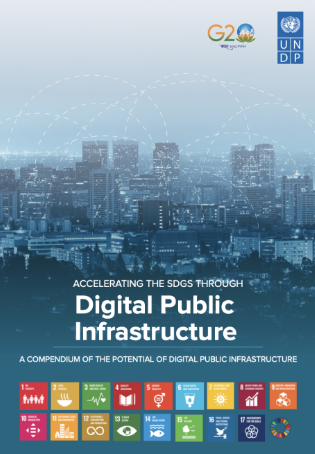The Digital Way Forward (GS Paper 2, Governance)

Context: Realizing the Full Potential of Digital Public Infrastructure (DPI)
- In today's rapidly evolving digital landscape, the effective implementation and enhancement of Digital Public Infrastructure (DPI) are critical to driving economic growth and social equity.
- India, recognized as a global leader in DPI development, showcases how innovative digital solutions can transform public services, enhance accessibility, and foster inclusive growth.
- This comprehensive exploration delves into India's achievements in DPI, the necessity of impact assessments, challenges faced, and strategies for optimizing outcomes.
India’s Leadership in Digital Public Infrastructure (DPI)
India’s Role
India's advancements in DPI, particularly through initiatives like Aadhaar and Unified Payments Interface (UPI), have set new standards globally.
- Aadhaar: Launched in 2009, Aadhaar is the world’s largest biometric identity project, providing over 1.3 billion residents with a unique identification number. This system has facilitated access to essential services like healthcare, education, and financial services, streamlining verification processes and reducing fraud.
- UPI: Introduced in 2016, UPI revolutionized the way transactions are conducted in India. By enabling instant money transfers between bank accounts via smartphones, UPI has dramatically increased the adoption of digital payments, contributing to a more inclusive economy.
DPI Expansion
India's leadership in DPI is not confined to its borders. Internationally, frameworks like the World Bank's ID4D initiative aim to promote inclusive identification systems, helping various countries develop their digital infrastructure.
- MOSIP (Modular Open Source Identity Platform): Developed by India, MOSIP provides a flexible and customizable digital identity framework for nations looking to build their identification systems. This initiative positions India as a key player in shaping global digital identity standards.
Financial Inclusion in India
The role of DPI in promoting financial inclusion has been profound. The growth in bank account ownership—from 25% of adults in 2008 to over 80% today—highlights this success. Notably, the fact that women hold 56% of these accounts is a significant step toward gender equity in financial access.
- Impact on Livelihoods: Access to banking services has empowered individuals and small businesses, enabling them to save, invest, and secure loans, thereby stimulating economic growth at the grassroots level.
Need for Impact Assessments
Measure Success
To ensure that DPI initiatives fulfill their intended goals, it is essential to conduct thorough impact assessments. These assessments provide valuable insights into the effectiveness of policies and programs, guiding necessary adjustments.
- Feedback Mechanism: Regular evaluations help create a feedback loop that informs policymakers about what is working, what needs improvement, and how resources can be allocated more effectively.
Preventing Inequality
Without systematic assessments, there is a risk that DPIs may inadvertently exacerbate existing inequalities. For example, marginalized communities may face barriers in accessing digital services, leading to unequal benefits.
- Equity Monitoring: Assessments should focus on equity, ensuring that all demographic groups, particularly vulnerable populations, can access and benefit from DPIs.
Need for Granular Intersectional Data
While macro-level data, such as Aadhaar enrollments or UPI transaction volumes, provides a broad overview, it lacks the depth necessary for understanding the nuanced socio-economic impacts of DPIs.
- Granular Analysis: Collecting intersectional data—accounting for factors such as gender, income level, and education—enables a more comprehensive understanding of how different segments of the population are affected by DPIs.
Challenges in Impact Assessment
Lack of Data
A major hurdle in assessing the impact of DPIs is the shortage of intersectional data. Current data collection methods often fail to capture essential demographic variables.
- Data Gaps: The absence of comprehensive data can lead to skewed interpretations of DPI effectiveness, making it difficult to identify who benefits and who is left behind.
Privacy Concerns
The tension between privacy and data collection poses significant challenges. While safeguarding personal information is paramount, obtaining anonymized, granular data is crucial for effective assessments.
- Balancing Act: Policymakers must navigate privacy concerns while ensuring that data collection is robust enough to inform meaningful evaluations.
Overcoming Challenges for Better Impact Assessment
3Ds — Design, Data, and Dialogue
Design:
-
- Integrate Assessment Mechanisms: Impact assessment should be an integral part of the initial design phase of DPIs. By embedding evaluation frameworks from the outset, systems can be optimized for ongoing assessment.
- User-Centric Design: Incorporate feedback from diverse user groups during the design process to ensure that the infrastructure meets their needs effectively.
Data:
-
- Accessibility: Establish trusted mechanisms for data sharing while maintaining privacy standards. Data should be accessible to researchers, policymakers, and stakeholders to facilitate informed decision-making.
- Improved Data Collection: Invest in technologies and methodologies that enhance data collection capabilities, ensuring it captures a wide range of demographic variables.
Dialogue:
-
- Foster Collaboration: Encourage open communication between government agencies, private sector players, civil society, and third-party assessment organizations. This collaboration can enhance transparency and build trust among stakeholders.
- Stakeholder Engagement: Involve multiple stakeholders in the assessment process to gather diverse perspectives and ensure accountability.
Conclusion
- Emphasizing impact assessments and institutionalizing this process is vital for ensuring that Digital Public Infrastructure not only transforms economies but also significantly improves the lives of millions.
- By addressing existing challenges and optimizing strategies for assessment, India can maximize the potential of its DPIs.
- While the journey has begun successfully, it is crucial to recognize that it is only halfway complete.
- Continuous evaluation, adjustment, and stakeholder engagement will be key to unlocking the full promise of digital public infrastructure, paving the way for a more inclusive and prosperous future for all.


